- Maui
- Volcanoes
and Mountains
-
We again woke up early and headed out for
another day of adventure. We started with a quick stop
at a local farmer's market (veggies, fruit, flowers,
and crafts), where we found picnic supplies including
fresh apple-bananas (short, tasty bananas), tomatoes,
and strawberries.
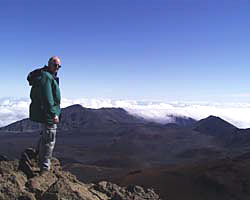 - Larry overlooking Haleakala
Volcano
|
- Many advertisements discussed the
merits of a dawn bike ride down the
Haleakala
Volcano road. We decided to check out
the volcano and save the ride for another
time. We love to mountain bike, but prefer
making our own arrangements, schedules,
and explorations. We made a good decision.
Although the ride sounds great, the
conditions aren't what we like.
|
The tours start at the top at dawn. People are
assigned slickers, bikes, and helmets. Everyone
follows a leader with a tour van following in the
back. It looks a little like the traditional horseback
riding experience where you spend your time watching
the rear of the horse in front of you and worrying
about the horse behind you. They stop for views and
hot chocolate along the way.-
- Instead of the bikes, we chose a short hike to the
Leleiwi Lookout and another hike to the top of White
Hill to view some ruins. We spent some time at the top
overlooking the Haleakala Crater or Valley, before
heading back down the mountain. We ended our trip with
a stop at the nature trail called Hosmer Grove. It was
a little disappointing, but did a nice job contrasting
native and nonnative plants.
-
- The nene
(Hawaiian geese) are one of the few native birds on
the islands. They look like geese and probably arrived
a few million years ago from Canada. They now live
away from the water in the high, arid lands near the
Volcano. Unlike most geese, there feet aren't webbed.
These endangered birds were almost extinct a century
ago. Now they can be seen near trailheads. We spotted
them near a maintenance road. The nene have a strange
duck-like call. Read more about the Nene
and Taking
Flight.
-
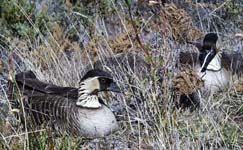
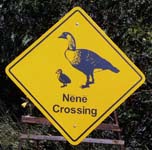
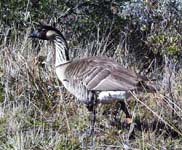 -
- As we drove down the mountain, the clouds began
rolling it. At one point we felt like we were driving
above the clouds. A strange feeling! The top of the
mountain is usually filled with clouds from midmorning
to mid afternoon.
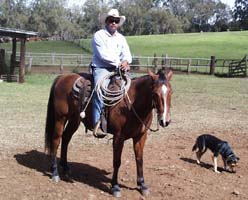 - Hawaiian Cowboy - A
Paniolo
|
- As we headed back into ranch country,
we saw the cowboy (called a paniolo)
on the left and stopped briefly to talk.
Original from The Big Island, he grew up
in a ranching family. The hillside is
covered with beautiful green grass and
healthy cows. In most cases, they ship
their cattle to the mainland for their
final grain feeding before market.
-
|
- Like any traditional cowboy, he had a
beautiful horse and cow dog. In addition,
like any good modern paniolo, his pickup
truck and horse-trailer were parked nearby
and his cellphone was attached to his
belt.
-
- Our last stop in Maui was the famous
Iao Valley and the Iao
Needle. You've probably seen a similar
photo of the needle in travel brochures.
This was a sacred place to the native
people and the location of the final
battle with King Kamehameha. In 1790, with
the help of captured westerner advisors
and a ship's cannon, Kamehameha
annihilated Maui forces killing many
people in this valley.
|

|
The heavily used state park was undergoing
some volunteer restoration which was a nice thing to
see. We stopped for our picnic lunch (cold roast
chicken, fruit, and veggies) next to a stream. Next,
we climbed the stairs to the viewing point to see the
needle. Finally, we explored the stream and renovated
garden area. They are planting native taro plants in
pretty pools.- After another evening and night in Maui, we got up
early and flew to our next island, Kaua'i.
-
- More Information?
-
Created by Annette
Lamb and
Larry
Johnson,
12/00
-
 - Return
to Trip Page
|